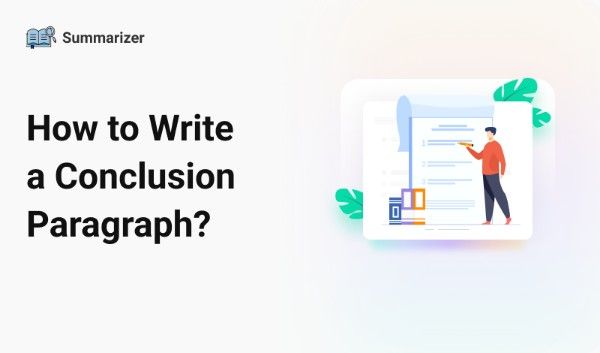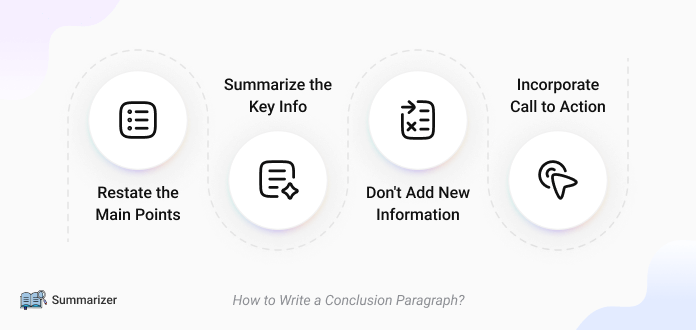
A conclusion paragraph sums up all the points discussed in an article, blog, essay, or research paper. It should be five percent of the total word count. The contents of a conclusion paragraph may vary according to the discipline or work type. However, they all provide a sense of closure and leave the reader with final thoughts.

In this article, we are going to discuss the most acceptable approach to writing a conclusion paragraph.
According to the Harvard Writing Center, a conclusion should remind the reader of the main idea. Try to restate the topic sentence or the thesis without using the same lines and words.
For instance, if you want to restate “Global warming is posing a real threat to our planet,” it could be stated as “Our planet Earth is deteriorating at a fast pace due to Global Warming.”
The goal is to mention your topic in different words. This can be done with the help of paraphrasing or summarization techniques.
Now, summarize all the important info and pieces of evidence that support your points. Mention them without going into detail. For example, if you are writing a conclusion for a comparison article reviewing multiple options, try to mention what each option is good for without mentioning everything.
Think of this as a moment to connect the dots for the readers, highlighting the big picture they should remember. An Interesting technique mentioned in a handout by UNC is to play the “So What?” game. This way, you can be assured that each line adds something important and links everything together.
It is important to remember that if your essay has pointed out any counterarguments to refute them, they shouldn’t be mentioned in the conclusion.
Many educational institutes like UNC and UON warn against adding new information in the conclusion paragraph. Stick to what you’ve stated without discussing things from a new perspective. Adding new data or arguments at this stage can confuse readers and affect the strength of your original points. Your conclusion should be the destination, not a new starting point.
Let’s say you wrote an essay on the “Benefits of incorporating turmeric into your diet.” You discussed research and studies showing the use of turmeric can lower the risk of deadly diseases such as cancer, heart failure, and other health conditions in the body paragraphs. Discussing and associating the use of turmeric with weight loss in the conclusion paragraph would be incorrect and irrelevant.
Adding a Call to Action is mentioned as an important step in writing an effective conclusion by Kent State University. It is usually written using persuasive language or phrases to motivate readers to take a specific course of action. It tells readers what to do next.
CTAs should align naturally with the content, encouraging readers to further explore related ideas, apply the knowledge gained, or engage with your content in other ways.
Examples of effective CTAs include:
Another great example is if you are writing on a topic that is similar to the ones you’ve already written about, you can use wording like, “for more such related work, visit…” or something along those lines.
Be sure to give your conclusion a thorough read to spot and fix potential mistakes related to grammar and writing. Remember, there’s always room for improvement. Make a list of what you want to add to your conclusion and check to see if you followed it.
Proofreading ensures that your conclusion reads smoothly. One way to do this is to read it out to the people and ask if they get an idea of what you have discussed in the paper.
When reading through your conclusion, ask yourself questions such as:
Writing conclusions. (n.d.). Writing Tutorial Services. | Indiana University
Writing a Conclusion. (n.d.). Kent State University.
Conclusions | Harvard College Writing Center. (n.d.).
UNC-Chapel Hill Writing Center. (2024, May 14). Conclusions – The Writing Center
Conclusion paragraphs. (n.d.). | University of New England
McNeil, K. (2006). Writing a Conclusion. The University of Newcastle.